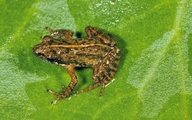|
Description
M 14-16 mm. Similar to B. sarotra but with a granular skin and usually with a vertebral stripe.
Holotype: Adult male, ZFMK 57444, from the forestry station of Manjakatompo, Ankaratra mountains, central Madagascar. SVL 15 mm, head width 4.5 mm; eye diameter 2.3, tympanum diameter 0.8 mm; distance eye-nostril 1.5 mm, distance nostril-tip of snout 1.2 mm; hand length 4 mm, length of foot and tarsus 12 mm; Tibiotarsal articulation reaches slightly beyond eye. Foot is very slightly longer than tibia. Tips of fingers and toes are slightly enlarged. Lateral metatarsalia are separated. Semi-circular femoral glands are present (2.8x1.3 mm, distance from each other 1.6 mm). Each gland consists of 7 large granules. Inner and outer metatarsal tubercle present. Hand without web, foot with a trace of web. Vomerine teeth absent.
Dorsal skin with dispersed, relatively large and distinct tubercles. Back light brown with dark markings, dorsilaterally some of them of longish shape. A distinct yellow vertebral stripe is present. A dark streak, bordered below by white, runs from the eye to the insertion of the forelegs covering the tympanum. Red colour is present on the underside of the tarsus, on the anterior part of the femur, and the insertion of the forelegs. The belly skin is translucent, the silvery belly can be seen through the skin. The underside of the legs is reddish translucent. The granules of the femoral glands are very distinct. The throat is translucent except two silvery white lateral stripes which run parallel to the lips and become visible in calling males during the inflation of the vocal sac. In preservative the colouration has faded, but the vertebral median stripe and the white stripes on the throat are still distinct. The granules on the back are much less distinct than in life.
Other specimens: We observed several more specimens of this same species (about 7) at the type locality. All had a very similar colouration; the vertebral median stripe and, as far as we could observe it, the white stripes on the throat were always present.
Similar species: see M. wittei.
Distribution and Habitat
Country distribution from AmphibiaWeb's database: Madagascar
Ambatolampy, Antoetra, Manjakatompo. In swamp areas on the central high plateaus of Madagascar, both at fully deforested sites and near montane forest. Occurs between 1,000-1,600m asl (IUCN 2008). Males call during the day from the ground, hidden in the vegetation, near puddles and ditches.
Life History, Abundance, Activity, and Special Behaviors
Habits: Calling males were found hidden under vegetation at the edge of small pools (slightly running water) in January. The calls were heard between 15.00 and 21.30 pm.
Call: Similar to B. sarotra but with a distinctly slower pulse repetition rate. Call structure is similar to the call of Mantidactylus sp. b, with a much slower pulse repetition rate: A pulsed note (24-28 pulses; duration about 500 ms; pulse repetition rate ca. 50/s) which is often followed by one or two short clicks. The call is repeated with a call repetition rate of about 20/min. Frequency is 3.5-4.5 kHz.
Eggs and tadpoles: Clutches which possibly belong to this species were found at the calling site. They were attached to stones ca. 10 cm above the water surface. Two freshly laid clutches contained 26-31 black eggs; black tadpoles hatched from these clutches.
Comments
Derivatio nominis: kely (Malagasy) = small.
References
Datong, Y., and Shunqing, L. (2004). Cynops cyanurus. In: IUCN 2008. 2008 IUCN Red List of Threatened Species. www.iucnredlist.org. Downloaded on 11 March 2009.
Glaw, F. and Vences, M. (1994). Amphibians and Reptiles of Madagascar. M. Vences and F. Glaw Verlags GbR., Köln.
Glaw, F., and Vences, M. (2007). Field Guide to the Amphibians and Reptiles of Madagascar. Third Edition. Vences and Glaw Verlag, Köln.
Originally submitted by: Frank Glaw and Miguel Vences (first posted 2000-10-24)
Edited by: Kellie Whittaker (2010-07-19)Species Account Citation: AmphibiaWeb 2010 Blommersia kely <https://amphibiaweb.org/species/4605> University of California, Berkeley, CA, USA. Accessed May 24, 2025.
Feedback or comments about this page.
Citation: AmphibiaWeb. 2025. <https://amphibiaweb.org> University of California, Berkeley, CA, USA. Accessed 24 May 2025.
AmphibiaWeb's policy on data use.
|
